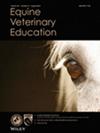Intra-articular corticosteroids: Systematic review of effects on osteoarthritis and joint health
Abstract
Background
The importance of intra-articular corticosteroid treatment for osteoarthritis, with its possible adverse effects, requires a comprehensive review.
Objectives
This review answers the following questions: (1) What evidence is available regarding the symptom-modifying and disease-modifying changes related to a single intra-articular corticosteroid injection for treating osteoarthritis in horses and humans? (2) What evidence suggests corticosteroids are detrimental to equine joint health?
Study design
Systematic review.
Methods
A systematic search was conducted in June 2022 in PubMed, CAB and the Web of Science. Inclusion criteria were applied to titles and abstracts. For each question, further criteria were applied. The risk of bias was assessed according to the study design.
Results
Searches generated 6417 titles. Twenty-three articles fit all inclusion criteria for single-injection corticosteroid treatments and 21 were included for their relevance to corticosteroid effects on joint health. Single-injection protocols lead to short-term symptom-modifying osteoarthritic changes with conflicting results regarding disease-modifying osteoarthritis effects. Healthy joints demonstrated disturbances in metabolism and tissue changes both in vivo and in vitro after corticosteroid. A dose-dependent effect was found in vitro.
Main limitations
There is a lack of studies regarding the questions, primarily for equine species. Furthermore, the majority of studies were rated as ‘unclear risk of bias’.
Conclusions
Symptom-modifying osteoarthritic changes after a single injection are short-term, and a consistent disease-modifying effect on osteoarthritis has yet to be established. Joint health is disturbed by corticosteroids as their effects on normal joints show adverse changes in tissues and metabolism.



 求助内容:
求助内容: 应助结果提醒方式:
应助结果提醒方式:


